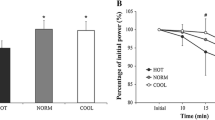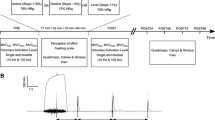Abstract
Exercise in the heat causes “central fatigue”, associated with reduced skeletal muscle recruitment during sustained isometric contractions. A similar mechanism may cause fatigue during prolonged dynamic exercise in the heat. The aim of this study was to determine whether centrally regulated skeletal muscle recruitment was altered during dynamic exercise in hot (35°C) compared with cool (15°C) environments. Ten male subjects performed two self-paced, 20-km cycling time-trials, one at 35°C (HOT condition) and one at 15°C (COOL condition). Rectal temperature rose significantly in both conditions, reaching maximum values at 20 km of 39.2±0.2°C in HOT and 38.8±0.1°C in COOL (P<0.005 HOT vs. COOL). Core temperatures at all other distances were not different between conditions. Power output and integrated electromyographic activity (iEMG) of the quadriceps muscle began to decrease early in the HOT trial, when core temperatures, heart rates and ratings of perceived exertion (RPE) were similar in both conditions. iEMG was significantly lower in HOT than in COOL at 10 and 20 km, while power output was significantly reduced in the period from 80% to 100% of the trial duration in the HOT compared with COOL condition. Thus, reduced power output and iEMG activity during self-paced exercise in the heat occurs before there is any abnormal increase in rectal temperature, heart rate or perception of effort. This adaptation appears to form part of an anticipatory response which adjusts muscle recruitment and power output to reduce heat production, thereby ensuring that thermal homeostasis is maintained during exercise in the heat.







Similar content being viewed by others
References
Bigland-Ritchie B (1981) EMG/force relations and fatigue of human voluntary contractions. Exerc Sports Sci Rev 11:75–117
Borg GA (1982) Psychophysical bases of perceived exertion. Med Sci Sports Exerc 14:377–381
Brown NJ, Stephenson LA, Lister G, Nadel ER (1982) Relative anaerobiosis during heavy exercise in the heat. Fed Proc 41:1677–1682
Durnin JV, Womersley J (1974) Body fat assessed from total body density and its estimation from skinfold thickness: measurements on 481 men and women aged from 16 to 72 years. Br J Nutr 32:77–97
Febbraio MA, Snow RJ, Stathis CG, Hargreaves M, Carey MF (1994) Effect of heat stress on muscle energy metabolism during exercise. J Appl Physiol 77:2827–2831
Fink WJ, Costill DL (1975) Leg muscle metabolism during exercise in the heat and cold. Eur J Appl Physiol 34:247–248
Galloway SD, Maughan RJ (1997) Effects of ambient temperature on the capacity to perform prolonged cycle exercise in man. Med Sci Sports Exerc 29:1240–1249
Gonzalez-Alonso J, Teller C, Andersen SL, Jensen FB, Hyldig T, Nielsen B (1999) Influence of body temperature on the development of fatigue during prolonged exercise in the heat. J Appl Physiol 86:1032–1039
Häkkinen K (1993) Neuromuscular fatigue and recovery in male and female athletes during heavy resistance exercise. Int J Sports Med 14:53–59
Hawley JA, Noakes TD (1992) Peak power output predicts maximal oxygen uptake and performance time in trained cyclists. Eur J Appl Physiol 65:79–83
Hunter AM, St Clair Gibson A, Mbambo Z, Lambert MI, Noakes TD (2002) The effects of heat stress on neuromuscular activity during endurance exercise. Pflugers Arch 444:738–743
Hunter AM, St Clair GA, Lambert M, Noakes TD (2002) Electromyographic (EMG) normalization method for cycle fatigue protocols. Med Sci Sports Exerc 34:857–861
Katch VL, Katch FI (1974) A simple anthropometric method for calculating segmental leg limb volume. Res Q 45:211–214
Kay D, Marino FE, Cannon J, St Clair GA, Lambert MI, Noakes TD (2001) Evidence for neuromuscular fatigue during high-intensity cycling in warm, humid conditions. Eur J Appl Physiol 84:115–121
Kayser B (2003) Exercise starts and ends in the brain. Eur J Appl Physiol 90:411–419
Marino FE, Mbambo Z, Kortekaas E, Wilson G, Lambert MI, Noakes TD, Dennis SC (2000) Advantages of smaller body mass during distance running in warm, humid environments. Pflugers Arch 441:359–367
Marino FE, Lambert MI, Noakes TD (2004) Superior performance of African runners in warm humid but not in cool environmental conditions. J Appl Physiol 96:124–130
Nielsen B (1996) Olympics in Atlanta: a fight against physics. Med Sci Sports Exerc 28:665–668
Nielsen B, Savard G, Richter EA, Hargreaves M, Saltin B (1990) Muscle blood flow and muscle metabolism during exercise and heat stress. J Appl Physiol 69:1040–1046
Nielsen B, Hales JR, Strange S, Christensen NJ, Warberg J, Saltin B (1993) Human circulatory and thermoregulatory adaptations with heat acclimation and exercise in a hot, dry environment. J Physiol (Lond) 460:467–485
Nielsen B, Strange S, Christensen NJ, Warberg J, Saltin B (1997) Acute and adaptive responses in humans to exercise in a warm, humid environment. Pflugers Arch 434:49–56
Noakes TD (2000) Physiological models to understand exercise fatigue and the adaptations that predict or enhance athletic performance. Scand J Med Sci Sports 10:123–145
Noakes TD, Peltonen JE, Rusko HK (2001) Evidence that a central governor regulates exercise performance during acute hypoxia and hyperoxia. J Exp Biol 204:3225–3234
Nybo L, Nielsen B (2001) Hyperthermia and central fatigue during prolonged exercise in humans. J Appl Physiol 91:1055–1060
Nybo L, Nielsen B (2001) Perceived exertion is associated with an altered brain activity during exercise with progressive hyperthermia. J Appl Physiol 91:2017–2023
Parkin JM, Carey MF, Zhao S, Febbraio MA (1999) Effect of ambient temperature on human skeletal muscle metabolism during fatiguing submaximal exercise. J Appl Physiol 86:902–908
Ramanathan NL (1964) A new weighting system for mean surface temperature of the human body. J Appl Physiol 19:531–533
Ray CA, Gracey KH (1997) Augmentation of exercise-induced muscle sympathetic nerve activity during muscle heating. J Appl Physiol 82:1719–1725
Ross WD, Marfell-Jones MJ (1992) Kinanthropometry. In: MacDougall JD, Wenger HA, Green HJ (eds) The physiological assessment of high performance athletes. Human Kinetics, Champaign
Rowell LB, Marx HJ, Bruce RA, Conn RD, Kusumi F (1966) Reductions in cardiac output, central blood volume, and stroke volume with thermal stress in normal men during exercise. J Clin Invest 45:1801–1816
Saltin B, Hermansen L (1966) Esophageal, rectal and muscle temperature during exercise. J Appl Physiol 21:1757–1762
Savard GK, Nielsen B, Laszczynska J, Larsen BE, Saltin B (1988) Muscle blood flow is not reduced in humans during moderate exercise and heat stress. J Appl Physiol 64:649–657
Schabort EJ, Hawley JA, Hopkins WG, Mujika I, Noakes TD (1998) A new reliable laboratory test of endurance performance for road cyclists. Med Sci Sports Exerc 30:1744–1750
St Clair Gibson A, Schabort EJ, Noakes TD (2001) Reduced neuromuscular activity and force generation during prolonged cycling. Am J Physiol 281:R187–R196
Tatterson AJ, Hahn AG, Martin DT, Febbraio MA (2000) Effects of heat stress on physiological responses and exercise performance in elite cyclists. J Sci Med Sport 3:186–193
Ulmer HV (1996) Concept of an extracellular regulation of muscular metabolic rate during heavy exercise in humans by psychophysiological feedback. Experientia 52:416–420
Acknowledgements
Funding for this experiment was provided by Medical Research Council of South Africa, the University of Cape Town Harry Crossley and Nellie Atkinson Staff Research Funds, Discovery Health and the National Research Foundation of South Africa through the THRIP initiative.
Author information
Authors and Affiliations
Corresponding author
Rights and permissions
About this article
Cite this article
Tucker, R., Rauch, L., Harley, Y.X. et al. Impaired exercise performance in the heat is associated with an anticipatory reduction in skeletal muscle recruitment. Pflugers Arch - Eur J Physiol 448, 422–430 (2004). https://doi.org/10.1007/s00424-004-1267-4
Received:
Accepted:
Published:
Issue Date:
DOI: https://doi.org/10.1007/s00424-004-1267-4




